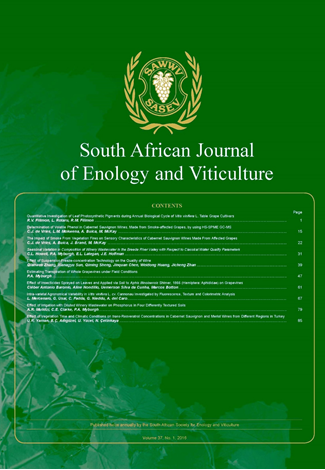Seasonal Variation in Composition of Winery Wastewater in the Breede River Valley with Respect to Classical Water Quality Parameters
DOI:
https://doi.org/10.21548/37-1-756Abstract
The annual wastewater quality dynamics of a winery from which wastewater was sourced for a fieldexperiment investigating the dilution of winery wastewater for vineyard irrigation were determined.
Annual mean monthly pH ranged from 4.2 to 6.8 and was lower during grape harvest than in winter.
Electrical conductivity (EC) increased from the start of harvest (February) and reached a maximum
in May, followed by a decline to a minimum in August. The increase in EC probably originated from
cleaning agents used in the winery, as well as K+ in the grape lees and spillage from the grape fermentation
process. With the exception of August, EC exceeded the critical value of 0.75 dS/m, which is the salinity
threshold for water used for grapevine irrigation. The mean monthly chemical oxygen demand (COD)
level increased from January and was highest at peak harvest (March). The K+ and Na+ levels in the winery
wastewater increased from February to May. The sodium adsorption ratio (SAR) ranged from 2.4 to 9.0
and increased from January to June. Although COD concentration in winery wastewater is the preferred
indicator of water quality for the South African wine industry, it did not provide a reliable indication of
suitability for irrigation. However, EC was strongly determined by the K+ concentration. This was to be
expected, since K+ is usually the most abundant cation in winery wastewater. Therefore, EC would be a
more reliable indicator of winery wastewater quality than COD concentration, particularly with regard to
the concentrations of cations such as K+ and Na+.
Downloads
Downloads
Published
Issue
Section
License
A copyright form will be e-mailed to the corresponding author when the manuscript has been accepted for publication.
In principle, the Author agrees to the following when he/she signes the copyright agreement:
I hereby assign to the SOUTH AFRICAN SOCIETY FOR ENOLOGY AND VITICULTURE (SASEV) the copyright of the text, tables, figures, supplementary material, illustrations and other information (the Material) submitted with the manuscript to be published in SOUTH AFRICAN JOURNAL OF ENOLOGY AND VITICULTURE (SAJEV) (the "Article"). The copyright becomes effective from the date the Article has been accepted for publication in SAJEV.
This is an open access journal, and the authors and journal should be properly acknowledged, when works are cited.
Author's may use the publishers version for teaching purposes, in books, theses, dissertations, conferences and conference papers.
A copy of the authors' publishers version may also be hosted on the following websites:
- Non-commercial personal webpage or blog.
- Institutional webpage.
- Authors Institutional Repository.
The following notice should accompany such a posting on the website: This is an electronic version of an article published in SAJEV, Volume XXX, number XXX, pages XXX - XXX, DOI. Authors should also supply a hyperlink to the original paper or indicate where the original paper (www.journals.ac.za/index.php/sajev/) may be found.
Authors publishers version, affiliated with the Stellenbosch University will be automatically deposited in the University's Institutional Repository SUNScholar.
Articles as a whole, may not be re-published with another journal.
The following license applies:
Attribution CC BY-NC-ND 4.0

